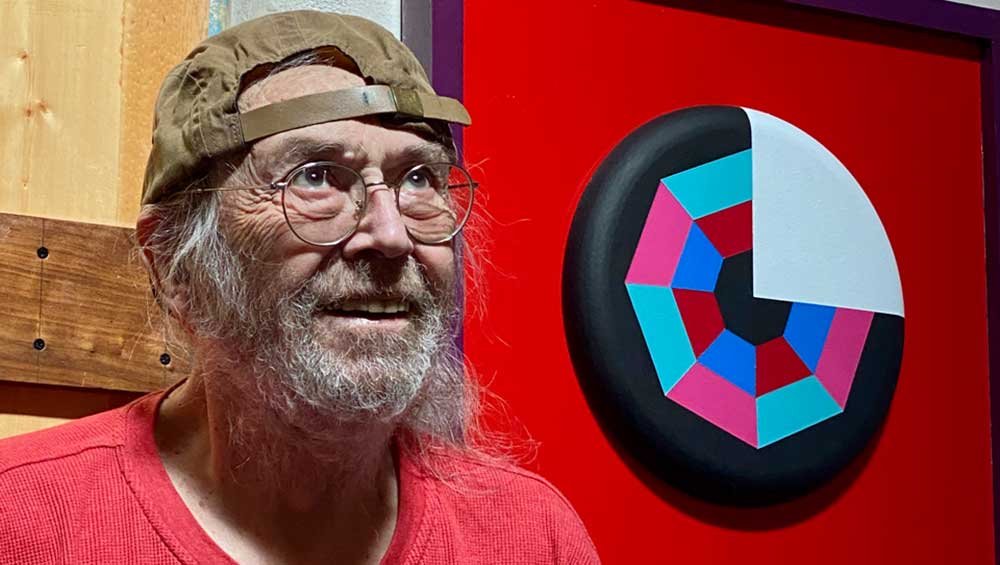
Ronald Davis. Courtesy Ronald Davis.
by ELIZABETH BUHE
The American multidisciplinary artist Ronald Davis (b1937, Santa Monica, California) has been painting abstractly for more than six decades, and his work has long been at the forefront of two-dimensional painting’s interrogation of illusionism and three-dimensionality. Influenced by Clyfford Still and Barnett Newman early on, Davis left gestural painting behind in favour of hard-edge painting while attending the San Francisco Art Institute from 1960 to 1964. After moving to Los Angeles in 1965, he was at the centre of its vibrant artworld, where he associated with the artists Judy Chicago, Larry Bell and David Hockney, the architect Frank Gehry and the gallerist Nicholas Wilder, among many others. In October last year, on the occasion of his solo exhibition Ronald Davis: The Paintings 1960s Through 2010 at David Richard Gallery in New York, Studio International spoke with Davis from his home north of Taos, New Mexico for a wide-ranging discussion about his materials and process, the development of his work, and the influential community of artists of which he has long been a part.
Elizabeth Buhe: While you were at the San Francisco Art Institute, how did you decide that you would start painting monochromatically? On the one hand, there was the figurative tradition and, on the other, abstract expressionism from artists such as Clyfford Still.
Ronald Davis: I studied with Frank Lobdell; Jack Jefferson was my main guy who I had maybe three semesters with, painting. Ivan Majdrakoff was the drawing instructor, who taught the Nicolaïdes method, gesture drawing. Artist Carl Glicko had been to New York and said everybody in New York is painting with acrylic paint. We went down to Flax Art Supply, and a little bottle of cadmium red was $4.50 (£3.60), and that was way too expensive for my budget. We went over to Oakland to Rohm and Haas and bought five gallons of AC33, which is kind of the standard clear matte medium: clear, glossy, or matte. I’m not sure we had matte back then. I just had my dry pigment, so we stirred in a little dry pigment into the AC33, and a few drops of Lux liquid detergent to be a water tension breaker. So, I started painting. Having been rejected from the master’s programme at the Art Institute and trying this acrylic paint, which was pretty new then, around 1963, I was painting ab ex in the spring. Glicko had gone to New York in the summer and come back. In December of 1963, I started painting hard edge. Maybe my fifth or so painting was Roll Your Own (Zig-Zag) (1963), very optical, one half with an isometric illusion of a cylinder. I had my antenna out looking for what a painting was, and how other people were defining what a painting was. I started using tape. I remember Mark di Suvero came by the San Francisco studio and said: “Yeah, Barney Newman’s a good tape man.” So that made me look at Barnett Newman a little more. Barney, I think, was an inspiration for a lot of people.
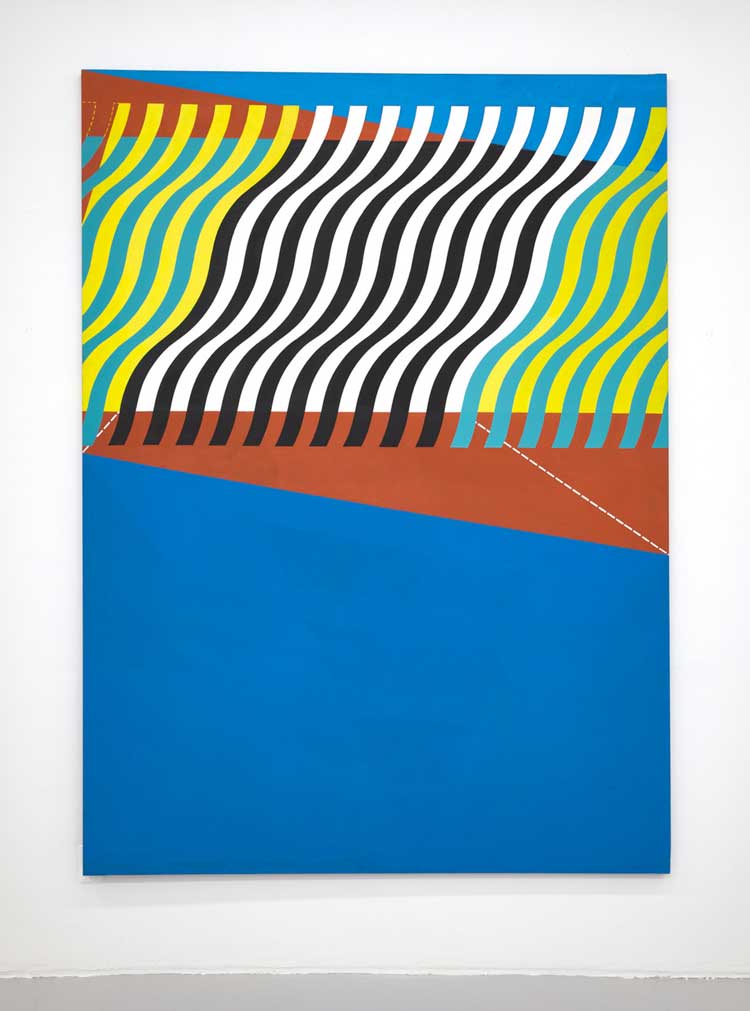
Ronald Davis. Wave, 1964. Acrylic on canvas, 95.25 x 69.75 x 1.25 in. Artwork Copyright © Ronald Davis. Courtesy David Richard Gallery. Photo: Yao Zu Lu.
EB: I want to keep following the development of your painting, but before we leave San Francisco, who were you seeing and meeting? During that time, Jay DeFeo was still working on The Rose (1958-66) in her studio.
RD: I visited her studio and saw The Rose in progress. I think Jay DeFeo was probably the best of all the Bay Area abstract expressionists. She was a powerful painter. Very fragile in person. I didn’t really get to know her in that sense. But I remember looking at The Rose, and as it was installed there in her place on Upper Fillmore, more towards the Bay. Sitting beside the painting on the floor, I remember two things. There was an old Christmas tree with a few ornaments on it, but no needles any more. Also on the floor were bankers’ boxes full of scraped-off paint. The Rose went through many, many iterations. On the floor were the remnants. That was pretty impressive to see somebody work on a painting for eight years. Magnificent. The painting shows that her intensity was in that painting. It was so much about how she did it, or how she used eight-inch-thick paint. Wally Hedrick built up an armature for it, after it got going for a while. I admired her. I was very taken by Lobdell’s paintings, too. Obviously Clyfford Still, other influences. Who did I hang out with? Manuel Neri, the sculptor, I remember being at his studio. That’s where I met Mark di Suvero. He was using Manuel’s studio for a month. He kept taking Manuel’s ladder, and incorporated into his sculpture. Manuel would have to go over there and get his ladder back out of the sculpture! I think Manuel would bring tea bags, and we would finish a tea bag and he would staple it to the wall. There was a whole wall of tea bags in the studio. Studios are important; where you work, where you spend those nights. I spent an evening at a party on Haight Street, in Haight-Ashbury, and met and spent half an hour, I guess, in the kitchen, drinking beer with Allen Ginsberg. Thrill of a lifetime.
EB: What was the transition to Los Angeles like?
RD: I went to Walter Hopps’ lecture down at Stanford. Judy Gerowitz (Chicago), was there, before she had changed her name. I really hit it off with Judy. We became friends, not romantically. She had moved to Pasadena. She said: “There’s a place around the corner. It’s $80 or $70 a month.”
![]()
Ronald Davis. Zig Zag Times Two, 1966. Acrylic on shaped canvas, 84.75 x 61.625 in. Artwork Copyright © Ronald Davis. Courtesy David Richard Gallery. Photo: Yao Zu Lu.
EB: What was Walter Hopps’ lecture about?
RD: All the LA painters he dug out, people you’ve never heard of. And people that Walter praised. I don’t have much memory of the lecture. He smoked a lot of cigarettes. Each time he’d set the filter on the podium. At the end of the lecture, there were like 10 cigarette butts sitting perfectly in a row. That’s when Walter was a curator at the Pasadena Museum of Art. Judy maybe moved there to Colorado Boulevard, where the Rose Parade is. I was on Fair Oaks, which is just around the corner. At that point, I’d been painting what I call my Optical Series, the 1960s paintings that were exhibited at David Richard Gallery in Chelsea last year [Optical, Shaped and Color Abstractions, Paintings: 1963-1965, November to December 2022]. That was the gallery’s thought, to show my early paintings to introduce me, and then, later on, to show a second show as more of a survey, which is the show that’s up now.
EB: Did Hopps visit your studio?
RD: That’s a good story. We’re over at Judy’s having dinner one night, and Walter came pounding on the door. He says to me: “I really like that blue piece that you’re working on over in your studio.” And I said: “Yeah, I was working on it today.” It was one of my first early monochromatic pieces. It was a long, angled piece. Walter said: “I really liked that piece,” and I said: “Wait a minute. Nobody’s seen that piece.” Walter hadn’t been over to my studio while I was working that day. How did he know? I thought about it for a while. “How did you see this piece?” And he says: “Oh, I went in your studio and looked at it.” I said: “What, did I forget to lock the door?” He says: “No, I used my credit card, flipped the lock.” That was Blue Angle (1965). I still have that piece. I had gone up to the local paint store and got some edging, some countertop aluminium stripping and framed it, because I was having trouble making shaped paintings for the first time, asking myself, should they have frames or not?
EB: You were supported by Hopps, you were friends with Judy Chicago, you had your first show with Nick Wilder, so you quickly found a community in LA.
RD: Yes. Nicholas Wilder was a visionary. He studied art history at Stanford, and started working in Lanyon Gallery, a little gallery in the Old Stanford Barn. A doctor and his wife started this gallery by going to Paris, buying eight Bernard Buffets and bringing them back. Nicholas started going around to Bay Area artists. Tom Holland was an early “get” for Nicholas. Arlo Acton was a sculptor. Bob Hudson. In 1964, Nicholas sold $70,000 worth of art, which in 1964 dollars is very successful. They were paying him $400 a month and giving him no commission and they were happy. The doctor and his wife were happy that he was running the gallery. I think Nicholas lost his funding because he had switched from law. The executors of his father’s estate pulled his money because he wasn’t in law school any more. He went to Dartmouth in pre-law, and when he graduated, he was set up to go to Harvard law school. Because he was gay, he wanted to be in California, so he said: “I’m going to Stanford.” He transferred from law and started taking art history. An anecdote about Nicholas is that he said: “You can probably name seven Renaissance artists. I can name 100.” And he would start and go through the names of Renaissance artists, one after the other. I actually heard it. He was proud of it.
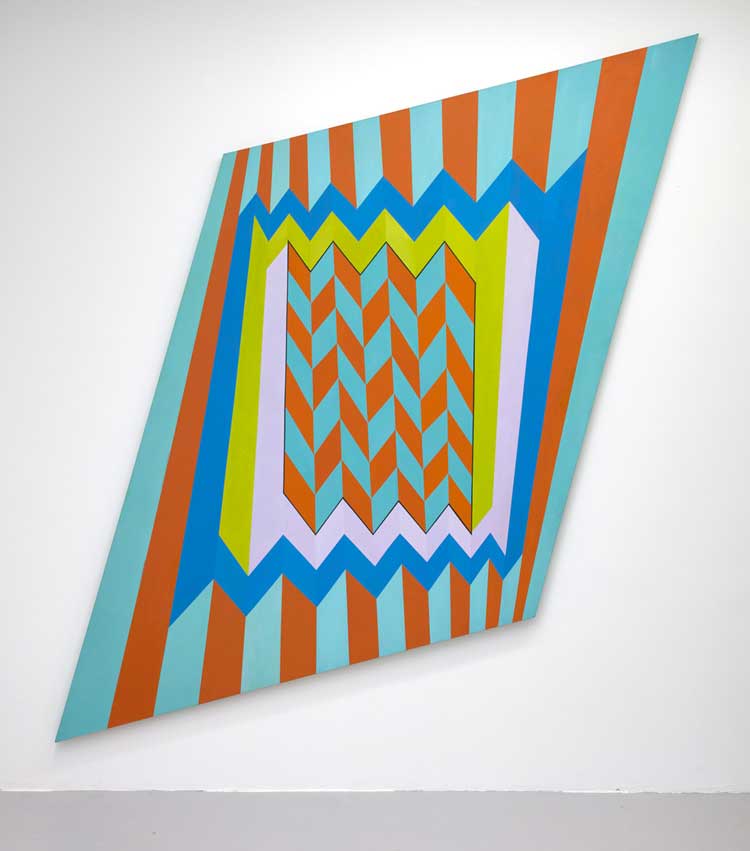
Ronald Davis. Dr. Zig Wig, 1964. Acrylic on canvas, 116 x 103 x 1.25 in. Artwork Copyright © Ronald Davis. Courtesy David Richard Gallery. Photo: Yao Zu Lu.
EB: What about him was visionary?
RD: That he was educated in painting. He could see art. He found people and promoted them. Somehow, he befriended Barnett Newman. This would be 1964, before Barnett was very popular. Barney had quit showing. He was actually an early investor in Nick’s gallery. Nicholas went around to his classmates at Stanford and got $1,000 apiece from 10 different backers. Katie Bishop threw in 10 grand and pretty much was part of his gallery in Los Angeles when he opened. He chose Los Angeles. New York would have been too tough. San Francisco, there’s no art. There’s no collector base, really. It’s a great place to study art, but not a very good place to sell art. He was starting his gallery, and he came to me that spring and said: “Do you want to be in my gallery in LA?” I debated it. I had had my first LA show, which was a two-person show with Judy. She was doing some ceramics then. I showed Roll Your Own Zig-Zag (1963) and a painting that got destroyed, called Gate (1964). They were hard-edge optical things. This was at Rolf Nelson, a little gallery on La Cienega Boulevard, just down the street from the Ferus Gallery. Nicholas was across the street, I think next to the Landau Gallery. Ferus was cooking, and the Studs were showing. The kindest person, the most open person, and the friendliest person was Larry Bell. I was mesmerised by seeing his first mirror boxes. Larry Bell was incredible even back then. He went out and raised $100,000 to get his vacuum chamber to build those glass boxes. What beautiful objects. Nicholas Wilder’s first show was Edward Avedisian. He also showed Agnes Martin early on.
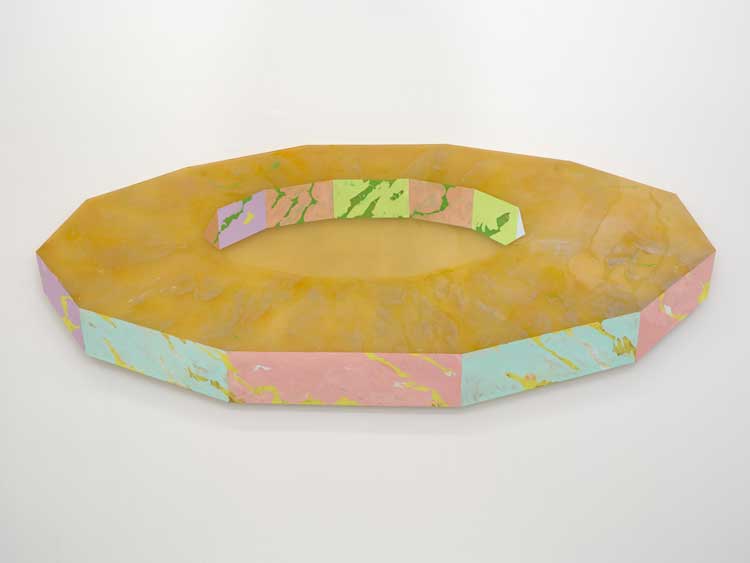
Ronald Davis. Lemon, 1969. Molded polyester resin and fibreglass, 50.5 x 132 in. Artwork Copyright © Ronald Davis. Courtesy David Richard Gallery. Photo: Yao Zu Lu.
EB: Let’s talk about your relationship with Wilder. Obviously, he supported you through showing your work. Did he support you in talking about the work? Did he come to the studio? Was he influential in thinking about next steps?
RD: He would come to the studio. Then maybe a few days later, we’d meet for coffee. And he would know each painting: its size, its colouration. We didn’t need to say: “What do you want to show?” It wasn’t about that. Back then, most any artist that would walk in his gallery, he was willing to go to their studio and say: “No, I can’t show you, but you can show with this other gallery.” Or: “You’re doing good, but you need another couple of years in the studio before, you know. I want to come back when you’re ready.” Very open to young painters, new painters.
EB: What things like that did he say to you?
RD: Put it this way, he put me in … Following my first one-man show there, which was kind of panned in the Los Angeles Times by Henry Seldis. Then two or three years later, [Seldis] did a 180 and really respected the painting. But at first, I think the monochromatic show was kind of shocking to them, because I had a five-foot square white minimal painting, just monochromatic, painted with the same colour as the wall paint in Nick’s gallery, which was an off-white, not the cold white they try to put in galleries these days. A warm light.
Barbara Davis [Ron’s wife]: Did Wilder encourage you after the monochromatic show was panned?
RD: Oh, sure. He put me in a group show and he’d gone to New York to André Emmerich and bought a Ken Noland for $7,000, and he had brought it back: a 12ft [3.7 metre] painting, a diamonds and stripe painting. He’d borrowed a Morris Louis from André. I forget what else, maybe a Jules Olitski. And then he was showing Noland. I don’t know if he’d shown him yet. He put me in a group show, a summer show with the heavy hitters from New York. About half his gallery were LA artists and about half were New York artists. The Ferus Gallery also showed New York artists, mostly because of Irving’s connection with Leo Castelli. He showed Andy Warhol in 1962. When I was there in 1964, Andy had the pillows filled with helium. I was going by the Ferus Gallery, and Andy was out in front with a tank of helium blowing them up. He says: “Yeah, well, one got away. Went up in the sky.” And I said: “POP.” [laughter] That’s all I said to him. Andy just looked at me. And then I saw him in New York a few times. And I said: “Hi, Andy.” I don’t know if he knew what or who I was. Probably did, he was pretty aware.
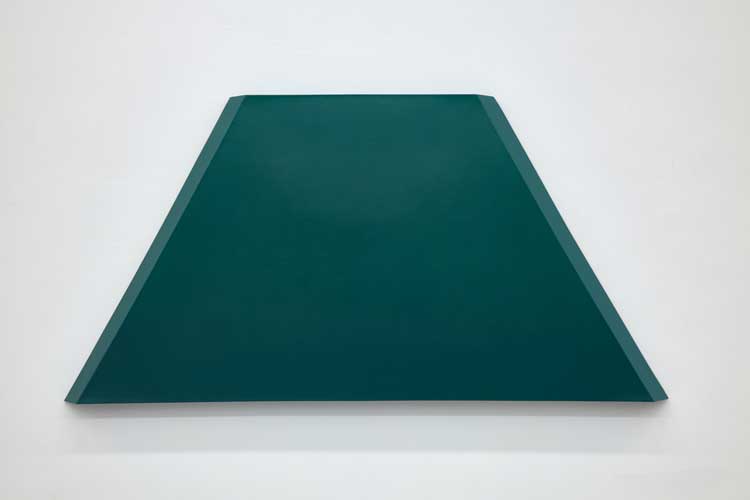
Ronald Davis. Sea-Green Trapezoid, 1966. Acrylic on shaped canvas, 34 x 67.75 x 3.25 in. Artwork Copyright © Ronald Davis. Courtesy David Richard Gallery. Photo: Yao Zu Lu.
EB: So Wilder encouraged you by putting you in that group show with the high modernists from New York.
RD: Yes. I said, Nick: “I don’t think I should be in that show with these real artists.” Bear in mind, I had been painting three years then. Here we’re with the best of the best in my mind. Just seeing a Noland as compared to anything, compared to a Billy Al Bengston, who wins that one? But Nicholas said: “Oh no.” And he hung my painting up, Green Skew (1966). And said: “See, you fit. You can hang with those guys from New York.” Which amazed me.
EB: Did that give you a sense of belonging to the artworld, to art history?
RD: Nick did an exchange. He was going to show Darby Bannard in LA, who was represented by Tibor de Nagy, in trade for my show at Tibor in 1966. I had done the Monochromatic Series. I started off with Green Skew (1966), a shaped canvas, a big U-shape, and I used two vanishing points to create an outline on the floor. I think I did a cartoon, small ink drawing. I got a book called How to Draw in Perspective down at the art store. Perspective for designers. I learned how to do one-point, two-point, and three-point perspective, which I worked in many times. All of my paintings. One of my mantras is: “Illusions are real.” I try to keep that in mind. [laughter] One of the things I found out in defining painting is that paintings are flat. Two-dimensional flat, and we’re representing … I didn’t figure out, because of my little knowledge of art history, I knew that Cézanne had faceted the mountain, made it into shapes, cubes, spheres, and that Picasso picked up on that, except he introduced cubism, which was kind of like, to me, a time sequence where you see the front view, and then you see the top view of the bottle. Then I got the little book called The Green Box at the Duchamp retrospective. I remember having an epiphany in the middle of the night, and getting up to look at the Oculist Witnesses in Duchamp’s Large Glass (1915-23), seeing that they are in perspective. Two artists who use perspective in their work are Duchamp and Davis. And I’m kind of proud of that.
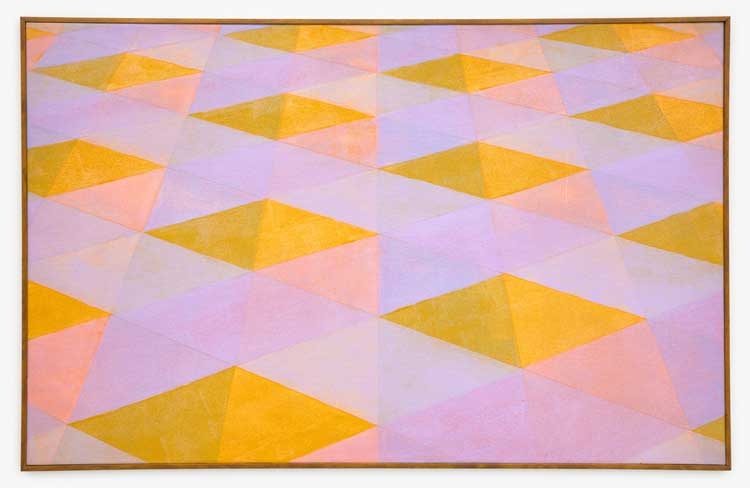
Ronald Davis. Crosby, 1978. Acrylic and dry pigment on canvas,
41.5 x 65.63 x 1.5 in. Artwork Copyright © Ronald Davis. Courtesy David Richard Gallery. Photo: Yao Zu Lu.
EB: How did you become interested in linear perspective or recognise that that was a direction you wanted to pursue? It’s not, as you say, necessarily natural for an abstract painter in the 60s.
RD: I perceived that from cubism forward to Rothko, painting had gotten flatter and flatter and flatter. A Rothko is, to me, three inches deep. The Z-axis in XYZ: up, down, and depth. All the paintings lacked depth. Some guys did it better. Picasso kind of had this in his 30s work. Guernica (1937) is faceted. But it doesn’t have the illusion of Renaissance perspective. I was at home, studying Renaissance painting. I enjoyed Duccio, because that period right before Uccello and Piero [della Francesca] and others reintroduced perspective into their paintings from the Greeks over a very short period. That changed everything, that changed painting. I saw a deficit. I mentioned Duchamp’s Oculist Witnesses. I got up in the middle of the night. I was thinking about it. I looked at this little photograph of the Large Glass, and determined that, indeed, the Oculist Witnesses were in perspective.
EB: What year was that realisation?
RD: 1966.
EB: Was there anything in your early educational formation that developed your proficiency or interest in perspectival space?
RD: At the University of Wyoming, I took a descriptive geometry course. I kind of flunked out on calculus. I couldn’t keep up. Descriptive geometry is mechanical drawing. Drawing 2D but in 3D. If you were plotting a sewer pipe, it would go 50ft north on the Y axis, and then it would turn and go down. You have to turn things, you have to think in 3D space.
EB: Did that course help you realise that you were good at turning things in three dimensions?
RD: I wasn’t any good at it! So, I came back from college and got a job working in a small sheet metal/aerospace company in Cheyenne, Wyoming, where they built monometers and barometers for testing the cockpit gauges in airplanes. I was just a sheet metal machinist who built the cases for them. I got to peek around the corner, and they were building a lean-tilt-yaw machine, which moves in three dimensions and was fascinating to watch. Makes you seasick almost, watching this table, which they mounted the instrument on for testing.
EB: Your realisation about the Oculist Witnesses in 1966 was the same year as the Tibor de Nagy show.
RD: Yeah. So that year I had done the Monochromatics. I was spraying on canvas with a spray gun and a little compressor. When you spray on canvas, it grows a fur. The fibres of the canvas come up. Then I sand it off and give it another coat of paint, and eventually it gets sealed. But it’s a lot of sanding, hard work, boring. Ron Cooper, who became a good friend – to this day, he’s here in Taos – suggested: “Why don’t you resin it to get a hard surface?” That’s when my first resin painting was just resin on canvas. And then I painted it, spray painted with acrylic. That was 1966 in the fall.
EB: The Tibor de Nagy show was the same moment when you recognised that you wanted to find a way to reintroduce linear perspective to this moment in art history, when everything had become so flat. You’re showing works such as Green Skew, which begins to introduce a sense of perspective. And this is important for people such as Michael Fried, because it showed a way that a shaped canvas could carry forward its logic beyond the kind of arbitrary Frank Stella deductive structure. You were showing the illusion of an object that had a shaped form. Let’s talk about that moment in criticism, and how you negotiated that. You clearly made the paintings before the critics were able to comment on them. But were you interested in that dialogue and the trajectory of what the critics were saying, and the way that they were talking about this progression of abstract painting? Did you see that you had a place in that conversation about high modernism? Or were you just making paintings, and then that’s what the critics happened to say about them?
RD: I was sitting at the library at the Art Institute and reading Art in America and Art International. I read Clement Greenberg’s essay Post-Painterly Abstraction. In that essay, Greenberg said that serious painting has to follow in the footsteps of Still, Pollock, Rothko and Newman. That’s the gold standard, if you want to be a painter. By that time, abstract expressionism was kind of second generation. I was thunderstruck … because it all started out back in Wyoming, some of the first paintings I tried were dripping, you know, like Pollock. I’d seen the famous 1949 Life magazine article on Pollock in a used bookstore.
EB: This was 1964, during Greenberg’s Los Angeles County Museum of Art [Lacma] show, Post-Painterly Abstraction?
RD: It was in 1962. I did see the Lacma show. A bunch of us, some of the San Francisco Art Institute artists like me – who shared studio and living space in the old Primalon Ballroom and Roller Rink on lower Fillmore in San Francisco – went down to LA to see that show. And that was where I saw my first Stella. That was before I met Barbara Rose and Frank. I saw the shaped silver paintings. I remember, particularly, a trapezoid painting with a hole in the middle, a pretty well-known painting [Frank Stella, Ileana Sonnabend, 1963]. And I was very impressed, particularly with the trapezoid. Because it laid down into one-point perspective all these, there was convergence of these things that I was pulling out of other people’s art because I was just a kid from Wyoming, and I didn’t know what to paint. I remember, though, I was ambitious. I wanted to make the big time. I wanted to follow in the footsteps of those four great painters, those four genius painters: Still, Pollock, Rothko and Newman. You can see that in Noland and Morris Louis, some post-painterly abstraction which had some funny, different iterations, some of them coming out of San Francisco. Not just me.
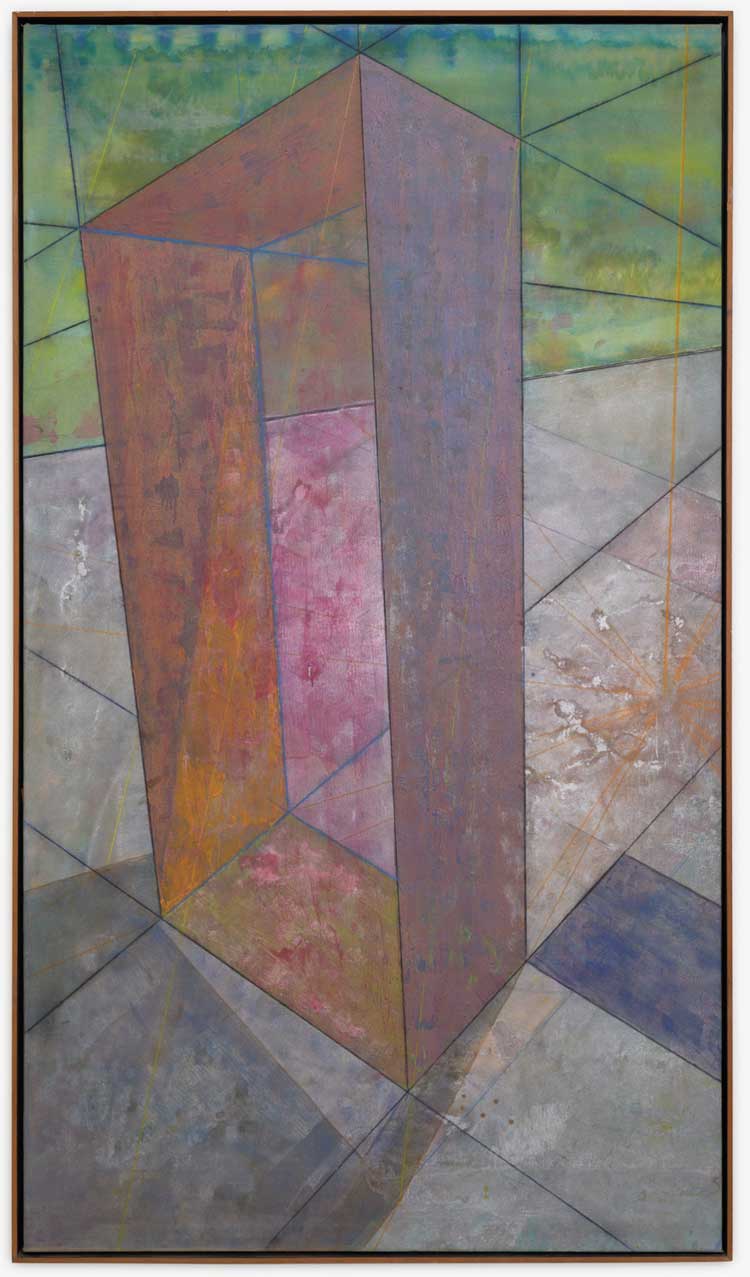
Ronald Davis. Interior Vent, 1974. Cel-vinyl acrylic and dry pigment on canvas, 111 x 63 x 3.75 in. Artwork Copyright © Ronald Davis. Courtesy David Richard Gallery. Photo: Yao Zu Lu.
EB: How did you see yourself in dialogue with Fried’s criticism? Were you consciously engaging with it?
RD: Clement Greenberg became very important. I think that was almost unique for California painters to kind of honour his contribution. Which is vast. I just want to jump forward. Important in my thinking was the way Clement laid it out, and how the minimalists, Don Judd in particular, criticised Greenberg scathingly. It’s almost ironic that minimalism was anti-Greenberg in that that’s where they planted their flag, as it were. These days the right wing tears down the government. This was “tear down Greenberg”. They attacked viciously over and over again. They still do, I think. He’s almost forgotten.
EB: Not forgotten, but still a bad object.
RD: Yeah. The object was to discredit Greenberg, therefore justifying minimalism. Frank Stella is a real painter, and I thought a serious one. I don’t think Clem did. But I like Frank. I knew him. What became important from Frank was painting as an object. And to this day I think my paintings teeter on that edge. Hey, it’s a painting. It’s two-dimensional. Yet it can be an illusion of a three-dimensional object. So, is it flat? Or is it not? I still look at a painting that way and judge it for myself as to its object-hood. Michael Fried wrote that important article Art and Objecthood (1967).
EB: In this moment – 1966, 1967, 1968 – to what extent did you deliberately want to be a part of that critical conversation, Fried being an extension of Greenberg?
RD: Fried in particular came out, was in LA for the Morris Louis show at Lacma. That was the first time I had met Fried, and got to know him vaguely, either at the opening or before. I think they had a dinner reception for him at Marcia Weisman’s house. I just confronted him and said: “What do you think of my Tibor show?” He said: “Oh, it was pretty good. It was a nice show.” And I said: “I wish somebody would write about it. I didn’t get three lines in Art News. I didn’t get any coverage.” He said: “Well, let me come by the studio. Maybe I can write something about it.” So, I said: “Why don’t you come on?” I’m a young artist. I just had a show at Tibor in New York, and nobody saw it. Except the people that came, and I wanted to say it. To that opening, Barnett Newman came, Frank Stella, Ken Noland, Agnes Martin and some other people. That group, the modernists all showed up for that opening.
EB: After you talked to Fried at Lacma he came to your studio.
RD: He came to my studio, and afterwards he went down to the Artforum office above the Ferus Gallery and said: “I want to write an article on Ron Davis.” And Phil Leider said: “OK.” I don’t know if Fried wrote it at his hotel, or afterwards when he got back to Princeton. I love that article because he taught me that I have been very lucky to have Michael Fried, Barbara Rose, Rosalind Krauss noticing me. Krauss I met at Castelli’s. I think she bought a painting of mine; she was looking at a painting, I think she bought one. Incidentally, the art critic John Elderfield saw my second show at Castelli in January 1971, and wrote a review in Artforum. Much later, when he was chief curator at MoMA, he pulled my resin dodecagon Ring (1968) from its collection, had it restored, and hung it above the entry hall reception desk. It was there from 2007 until sometime in 2009. I had a pretty auspicious beginning there. I had the show in 1966, and in 1967 I had a show at Wilder of resin paintings.
Nicholas had been in New York and had talked to Leo [Castelli]. I probably very much wanted to be in André Emmerich. But there was no room at the inn for me. Leo was showing Don Judd and Morris [Louis] at that time. Minimalism was starting to hit. Leo saw my paintings as a minimal painter that would fit in his stable. He was trying to go beyond just Jasper Johns and Robert Rauschenberg, who remained his love. I was at Castelli for almost 15 years. By the time he had moved downtown, I was number 37 out of 45 artists. I didn’t fit Castelli from the beginning.
As I say, I’m eclectic. There are pop art elements in my work. There are colour field elements in some of my work. Greenberg was there at the Lacma Morris Louis show. That’s a good story. Down at the Shrine, they used to have the rock and rollers. I took Ken Noland and Clem Greenberg and that night Cream were playing. It was a wonderful kind of venue. I remember learning how they made the projections by putting a big watch crystal over a projector, pouring oil and water in, and it was projected on the wall. Clem was pretty fascinated by that image of liquid flowing. Single Wing Turquoise Bird were at the Cream concert, doing a live light show.
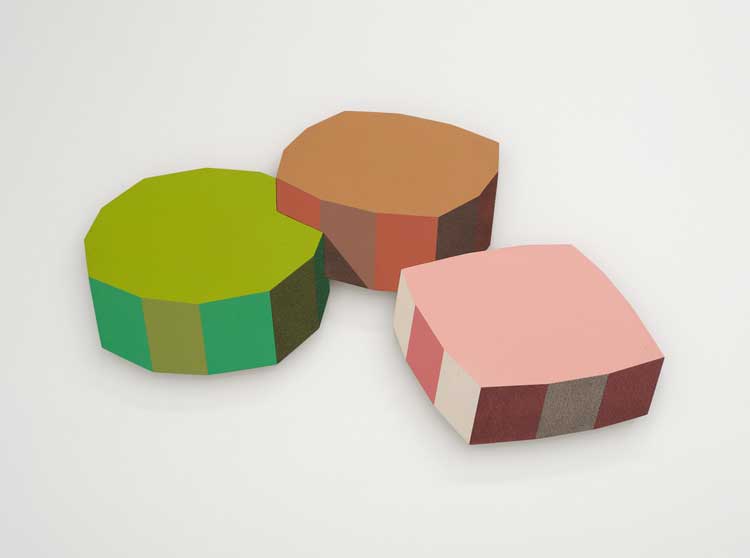
Ronald Davis. Three Polygon Slabs, 1988. Cel-Vinyl Acrylic Copolymer and Nova Gel on birch plywood, 30.13 x 52.625 in. Artwork Copyright © Ronald Davis. Courtesy David Richard Gallery. Photo: Yao Zu Lu.
EB: When Fried came to your studio in advance of the 1967 Artforum article, would he have seen anything else besides slab paintings, such as a crab painting, in your studio?
RD: They weren’t made yet. No. I was talking to Barbara Rose, and we were talking about horoscopes. I’m a cancer. I’m a crab. I go sideways: forward and back. She says: “Well, that painting looks like a crab.” It’s not really. I call it something else. The Pentagon series. But she coined the name and it stuck.
EB: You were talking about the light shows. What about psychedelia? In about 1968 or 1969 you started introducing drips in your slab paintings, which might relate to a broadly psychedelic aesthetic or liquid light show pours.
RD: I’ve never had a tie-dye T-shirt. I’m not a hippie. I’m an old beatnik philosophically speaking. Somebody came to the Art Institute with a pint of LSD from Switzerland, the real stuff. Early on. Half the school dropped acid. And we did it very, very thoroughly. We read all the literature from Timothy Leary when he was popular. We had a kind of guide, or some people that were staying straight. So, I dropped acid and started smoking weed. Most of my paintings are me drunk and stoned, and those resin paintings …
EB: It’s interesting that you have made work while stoned or high. I wonder what impact that had on the work.
RD: The Slab series is divided into a nine-square grid like Ad Reinhardt. I may have gotten it from [Kazimir] Malevich. I was looking at the Russian constructivists. I define myself as partially an old-fashioned constructivist as opposed to an abstract expressionist. But it’s about making things. Like Blue Angle (1965). I could look at a Noland diamond and see it. It’s a striped painting. I’ll paint a stripe, and boom! That’s what Blue Angle becomes. With the Slabs, I remember getting a little stoned one day and having a tough time working on one of the paintings in the 2022 David Richard show, my Double Diamond (1967), a large, 12ft shaped canvas. I was working on that, and I just sat down with a sketchbook and drew out eight of those paintings, little line drawings, funky. Did the idea, the concept of those paintings come after that, come from the drugs? Absolutely not. It was already there in my brain. But maybe it’s the lack of self-consciousness that you get when you’re stoned. You know, it just pops out without thought or effort. Sometimes the drugs help it, and sometimes they turn on you.
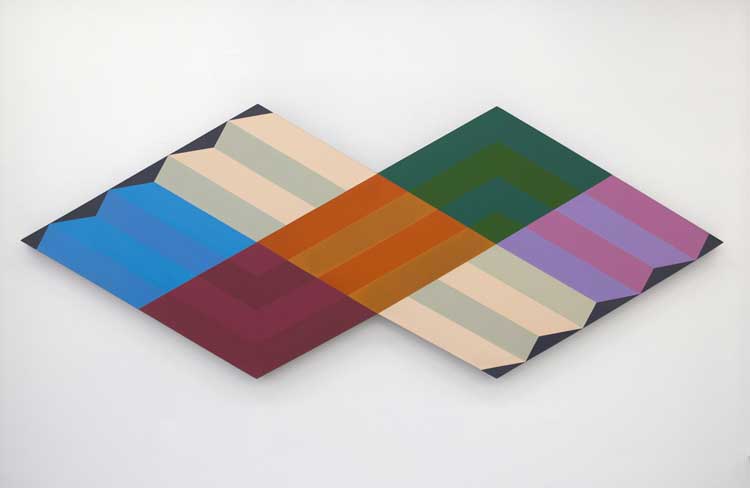
Ronald Davis. Double Diamond, 1965. Acrylic on canvas, 60 x 156.5 x 5 in. Artwork Copyright © Ronald Davis. Courtesy David Richard Gallery. Photo: Yao Zu Lu.
That’s what happened with the acid. After four or five times taking acid, I said: “This shit’s poison.” I haven’t taken it since. I was in the fast lane in Hollywood later on, and did quite a bit of coke and angel dust, and whatever somebody gave me, a hunk of opium. I was ready to smoke that opium and I was ready to move to Thailand, get myself a shelf, to lie on and puff on an opium hookah. It seemed like a good thing to do. I remember the sensation of the back of my head just dripping. I can tell you about one acid trip. I was sitting in a small room, with a candle burning, with other people. I saw the ring around the candle. Then I looked another way, and the ring was still there after reaching my eye. And my friend laughed and pushed the ring across the room, where it hit the wall, shattered, and ran down right across the floor. That little alteration of perception could be relevant.
EB: I think so. I wanted to ask you about the perception of your work for a viewer. You have said that you are interested in illusions. To put this in the context of the other artists in Los Angeles who were making sculpture about perception, whether James Turrell, Robert Irwin, De Wain Valentine or Larry Bell: their work is different from yours, but a commonality is that you bring to the fore a question of how we perceive. Your paintings are paintings, but they also ask us, when we look at them, to think about what we are seeing and how we are perceiving it. I wonder if you see yourself in that conversation of 60s artists who were making work about the self-consciousness of perception.
RD: Perception is key. I’ve thought about or studied quite a bit about pattern recognition. And I’ve done pattern paintings. Another thing I pulled from someplace else. I’ve tried to always be a painter, though. I don’t really paint for the audience. As Noland said: “I paint for the money because money allows you the freedom to go buy materials and rent a nice studio or build one or join the good life.” A materialistic American. That’s part of my fibre. Being an American, and specifically being a westerner. It’s very different coming from Wyoming, or kids from Montana, Colorado who had been drawn to the Art Institute. We called ourselves the Rocky Mountain Fauve Boys. We were the party guys. We were the hard painting guys. But the LA people, I got to know ’em, I got to be friendly with most of them. But art dialogue – that was Greenberg, and that was Bible, free contributing, to you know, my self-didactic teaching myself, finding out what a painting is. That’s still an exploration I do now.
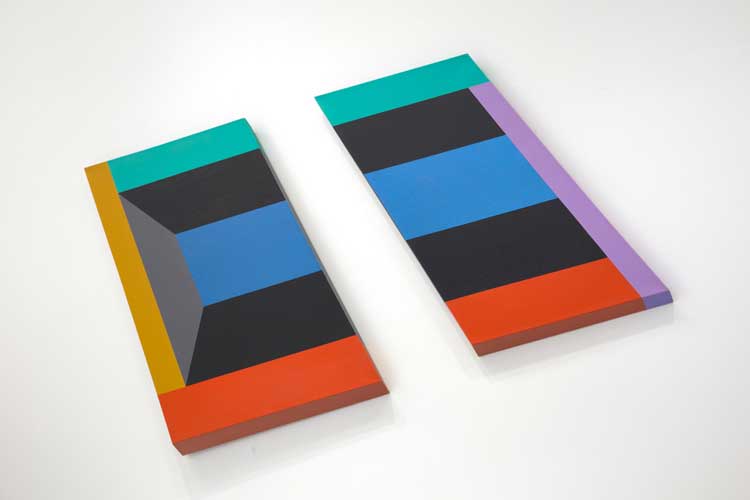
Ronald Davis. Two-Thirds Lock Slabettes, 1985. Diptych, acrylic on shaped canvas, 50 x 93 x 2.75 in. Artwork Copyright © Ronald Davis. Courtesy David Richard Gallery. Photo: Yao Zu Lu.
EB: In his 2015 essay, republished in the catalogue for this show, Dave Hickey said that you influenced Robert Irwin. Do you know what he meant by that?
RD: Hickey is a curious figure. I’m sorry he died. I knew him slightly. I disagree with Hickey that I inspired Bob Irwin. Ed Moses was far more influential on Irwin and, for that matter, on Turrell and others working with the effects of light and space on various environments. Ed Moses showed at Riko Mizuno’s LA gallery and knocked out a big hole in the exterior roof and ceiling of a room in the gallery to allow the changing light of the sun and clouds to continually affect the experience in that room. Moses made this installation before Irwin and Turrell worked on their light and space works. My 1960s illusionary resin paintings “violated the fourth wall”, if you will, affecting the spatial environment of a room by excavating “into” walls or pushing “out” into the room.
I was also creating sound sculpture at the time, as a way of affecting environments with music and sound. Dave Novros was very important in pitching monochromatics. It seemed right to me, because I was running out of gas with the Optical Series. That transition into resin, Ron Cooper had suggested. I went down to Hastings Plastics, where De Wain bought supplies. De Wain really did some incredible four-barrel pours of resin that his work would take. He had coolers on the mould. Quite elaborate. I just had a couple of buckets with a barrel of resin with a pump on it, and I’d throw colour in. I did install an exhaust fan. I quit after five years using resin. Who’d want to make paintings at a plastics factory?
EB: Besides the optical effects, what else drew you to the resin?
RD: It was a hard surface to paint on. I got a book from Hastings Plastics, How to Make a Fiberglass Boat. The first thing you have to do is make a mould.
EB: Do you still have that book?
RD: Yeah, I think it’s in storage. I can’t get out there any more.
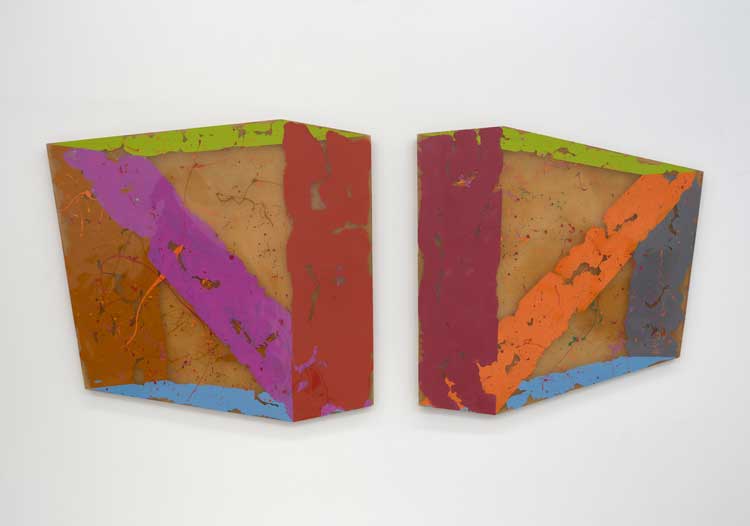
Ronald Davis. Double Diagonal, 1969. Diptych, polyester resin and fibreglass, 58 x 129 in. Artwork Copyright © Ronald Davis. Courtesy David Richard Gallery. Photo: Yao Zu Lu.
EB: I wanted to ask you about the resin paintings that I saw at David Richard gallery. In Double Diagonal (1969) it looks like there are oily dots in the beige, yellowish passage. Can you explain first of all what we see, because it looks like you can see a grid of a canvas. Is that canvas behind the resin? Or is that fibreglass? And second, what are these darker dots?
RD: The resin paintings were painted backwards, face down on a Formica mould, built on a big table 5ft x 12ft. That’s just transparent resin. With fibreglass. The resin I used is the equivalent of paint. I used it as paint, and that is like raw canvas. Only it’s raw fibreglass. Yeah, I see the grid here. That’s fibreglass cloth which is a reinforcement. It’d be like a canvas texture in traditional painting.
EB: Yes, I understand painting it backwards.
RD: At first, I lay in a coat of resin. The dark dots are actually shadows cast from the coloured resin surface – shadows of the shapes and splatters falling on to the interior backing of the hollow support construction. Important if you look at another painting, for example a couple of dodecagons from the middle period that Frank Stella came by the studio to look at. He fixated on the fact that each facet of the ring, or dodecagon shape, was a painting in itself, and sometimes the facets met, came together. The fact is that a “do-deca-gon” is a 12-sided polygon. “Do”, two; plus 10, “deca”, equals 12 sides or angles. People get it confused and call them “dodecahedrons,” which is a primary shape, a Buckminster Fuller “Bucky Ball”. What I’m saying is, I make these paintings face down and then back them with the resin and fibreglass cloth. It’s just what the material dictated. A lot of stuff happened that wasn’t intentional. What do I leave out? That’s something Lobdell told me. He told me to ask myself: “What’s simple? What’s important? A lot of times it’s not what you put in a painting, but what you leave out.”
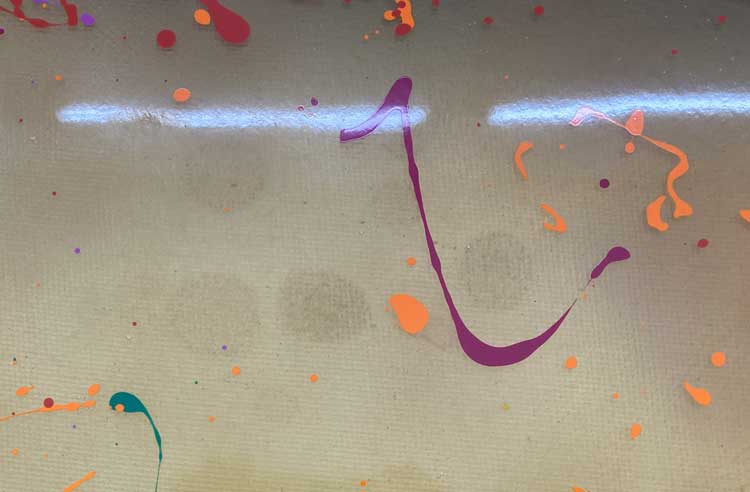
Ronald Davis. Double Diagonal, 1969 (detail). Photo: Elizabeth Buhe.
EB: As we are talking about the dodecagons, in the 60s did you know the illustration of Albertian perspective, where the lines of vision converge?
RD: No, I’ve never seen that before. But I remember reading Alberti. Just skimmed it then. The Uccello chalice is really pretty good. It cracked me up. Vija Celmins did a reproduction of the chalice.
EB: Would you like to talk about printmaking and how that fits into your practice?
RD: I wanted to say after my show at Tibor, I got a call. It was Leo Castelli, and he says: “I think you need a better gallery.” As I said, I would have liked to show at Emmerich. But Leo invited me. Probably Barbara [Rose] and Frank [Stella] pushed me in and said: “Here’s a young California guy. Be good for you to show him.” And Barbara’s persuasion boosted me. She’s been very important. She wrote catalogue essays for me. I think she loves the paintings, but she’s not quite understanding what they’re about.
EB: What was she missing?
RD: I think Dave Hickey hit it, and I was really pleased. The emptiness of California art. I don’t know how he put it.
Barbara Davis: The profoundness of the space, the quietness of what you were doing. It’s less frenetic than a New York feeling. In California there’s space. It’s the edge of the creativity of America before it takes off into the sky into the Pacific. There’s this cleanliness to the horizon, and this kind of blank, not blankness, but some kind of freedom that was different than New York.
RD: The Art Institute was a kind of beacon, as Chouinard was in Los Angeles, but for the most part nobody knew what art was. As I say, it was challenging to show with the big boys, as I mentioned earlier. I didn’t know if I fit. There was a lot about, what’s the content of a Morris Louis? It’s on occasion spiritual. I can characterise myself as a box in time and space. That has to do with perception, too. Dave Hickey used the word. The emptiness of California or western art, and how he had approached California art. Trying to fit it into New York painting. And it’s different! It’s different in Clyfford Still, as opposed to mainstream abstract expressionism, like Willem de Kooning. Hickey is a good writer. It’s much more about concepts.
EB: Did you have a community around printmaking in Los Angeles?
RD: Yes. I had a studio on Pico Boulevard in 1966 and David Hockney was teaching at UCLA. He wanted a love nest. So, he asked Nicholas if he knew of any studios. He says: “We’ll go see Ron. Maybe he knows.” Behind my place on Pico was a little cottage. One room and a bedroom, or kitchen and bedroom. I forget his boyfriend’s name. He’s with him still. Anyway, that’s one of my influences. He came over one day, and we were smoking a joint and playing chess. We played the first game, and I won pretty quickly. And I said: “That’s what you get for playing with a geometrician.” The second game, I did a five-move lose your queen, queen sacrifice. [laughter] I lost my queen. I turned my queen over, and David said to me: “That’s what you get for playing with queens.”
EB: That’s a good one. I wonder how many times he got to use that line.
RD: In the 1980s, I was honored at the Gemini GEL Print Show at the National Gallery in Washington DC, to which Gemini had donated its full print collection in an archival bequest. While we were there, all the Gemini artists went to a party at Fitzhugh Farm in Phoenix, Maryland to see the Meyerhoff collection. Everybody – they took a busload of us out to look at the collection. David [Hockney] said: “What’s all this about ‘conceptual artists? Every painter is a conceptual painter.” Kind of like all the pluralism of the art world. In the centre of that is old-fashioned painting. I don’t think it has to be painted on canvas. It can be resin on canvas. It can be a lithograph, but the concept is plain, old-fashioned painting.
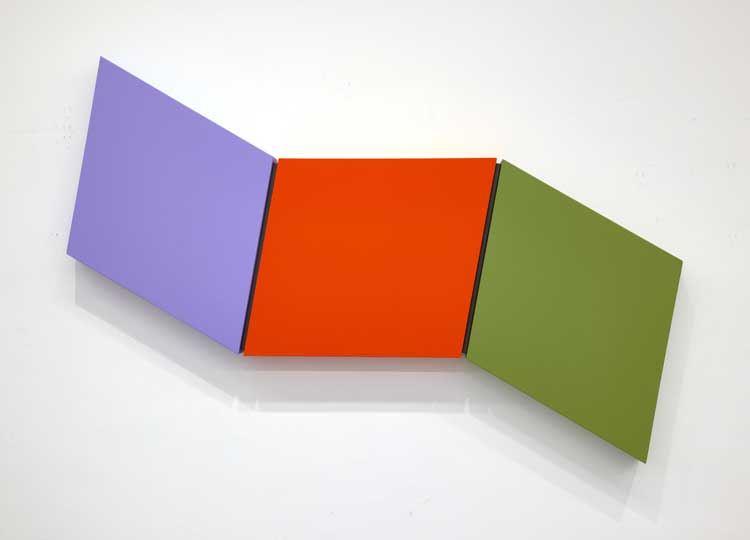
Ronald Davis. Three Color Wave, 2009. Acrylics on expanded PVC plastic, 35.5 x 54.25 x 3 in. Artwork Copyright © Ronald Davis. Courtesy David Richard Gallery. Photo: Yao Zu Lu.
EB: David Hockney made a painting of Betty Freeman inside of a glass house called Beverly Hills Housewife (1967). Did Freeman collect or support you?
RD: Yeah, she had a resin Slab painting, a very beautiful one. A blue one. I saw David painting Beverly Hills Housewife propped up in his little kitchen. It kind of blew my mind. I was watching him paint over the weeks. I’d drop in for coffee. He’d come by my place. Wonderful man, wonderful man! He was painting the grass down at the bottom of the painting, one blade at a time. And I was looking at that. I said: “Well, come on, give me a break.” Then he painted everything, the whole painting, again – on top of the first painting and, all of a sudden, that grass just popped, and that was a great lesson for me to see how he pulled whatever he’s doing and how meticulous he was. What a great draughtsman he was. That’s maybe my lack. I never learned how to draw. As Billy Al Bengston said, took me five years to learn how to use a ruler.
EB: Did you hang out at Betty Freeman’s parties?
RD: I remember going to her house, to a La Monte Young concert. La Monte had been playing the gamelan. She had a concert with a big gamelan on her roof, blasting off. In 1969, I bought a Buchla 100 synthesiser and played with the object of making sound sculpture. I got to know Don Buchla, builder of these incredible instruments, what Rolling Stone called the Rolls-Royce of synthesisers. All the Euro-built synthesisers have picked up the Buchla technology, because Buchla copyrighted nothing. On his sheets, he would have an X with a circle around it that said: “May be used by anybody, any place that they so choose.” He would send it out, you could get the schematics from him to repair them. You could send the schematics so your local guy could fix it. So, I got to know him. I bought a Buchla 200. One of the modules in the 200 was a spatial locator, which was quadrophonic four speakers. You could take a given sound, and spin it around the room, or do crisscrosses. And so that was my idea of sound sculpture.
EB: Are you working with sound sculpture now?
RD: I had to sell them … I had four synthesisers up through the 80s, and it became just too much. When I moved out here, I brought the synthesisers. But I couldn’t get them running again. I sold them to a synthesiser museum in Canada.
Barbara Davis: However, he has a small keyboard now, and new software.
RD: I recently wrote a 12-second pattern composition that loops, using the Garage Band app on my Mac computer. Early on, in the 1960s, I went to a party when I was in New York. Somebody says: “Let’s go to this party.” It was Philip Glass’s place. I fell in love with his pattern music. It’s not called minimal music, but it’s during that time. And in 1966, La Monte Young came to my studio with a guitar amp and a sound generating oscillator, and did his practice. He would chant or do vocal droning for an hour every day. He’d set a low pitch and maybe another pitch one half-step off. He would get a phase beat going between the interaction of two wavelets. Bum bum, bum bum.
EB: When was it that he came to your studio?
RD: That was on Pico Boulevard. Early 60s. That would probably be 1965.
EB: Are you painting now?
RD: I haven’t painted for quite a while, because of my heart attack, and now I have a pacemaker. That laid me back. I can’t use the power tools any more. But now, there’s a Circle series which I’ve been working on since the Covid quarantine in 2020. Confronting a circle, the first step, which I had to work on for months, was to find the centre. And then I finally realised that what I had was a polar view of a sphere looking at it from the top view of the circle. I couldn’t use the power tools any more to make shaped paintings. I just looked up in Dick Blick and bought some circular canvases pre-sized, which is kind of junky, but I can get the acrylic to stick to it. Just gesso over the pre-sized. I don’t know if they’ll fall apart or not. I always thought that that was up to the conservators. People frequently want me to fix the paintings. They set [the resin paintings] on a concrete floor, and they chip, so there’s often a lot of damage, and then they send them back. I had a studio assistant, Jim Grant, who went to Chouinard and learned ceramics and actually repaired ceramic pieces, or pre-Colombian or whatever. When I quit with the resin, I gave him all my colours. He knew what I had done in the studio, and then kind of riffed off on that, like one would do like spider traps all through the resin. He kind of opened it up with a hypodermic, put new resin in, and pulled it back together. I think he’s passed on now. He did that for a lot of repairs, he was wonderful. Now there’s a guy in Long Beach (San Pedro), Eric Johnson, who’s done a couple of restorations, but he really wants to work on his own work. Jim Grant gave him all that stuff. Yeah, those colours are from Hastings Plastics and a place in Orange County called Rahn Plastics that had pretty good colours, just colours that you poured into the resin. I mentioned the toxicity of it. It’s just like the Styrene, which is mostly primary.
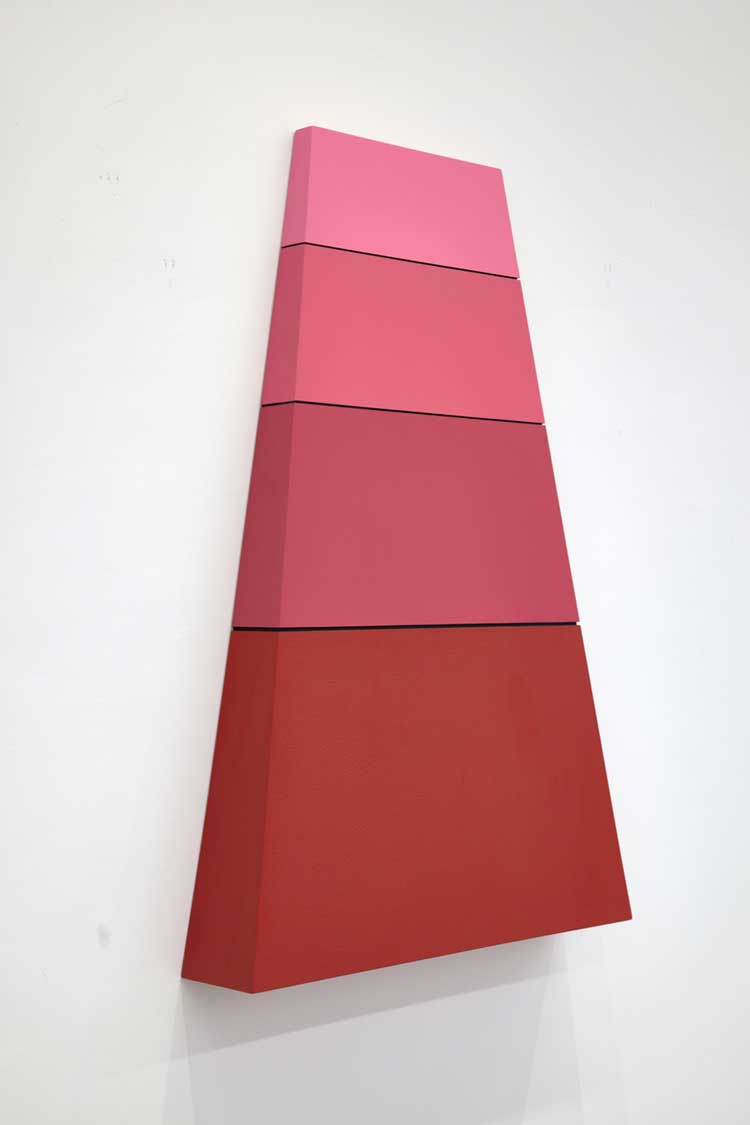
Ronald Davis. Rose Red Taper, 2009. Acrylics on expanded PVC plastic, 47.63 x 31.75 x 6 in. Artwork Copyright © Ronald Davis. Courtesy David Richard Gallery. Photo: Yao Zu Lu.
EB: Did you protect yourself in any way, with gloves or a mask?
RD: I had rubber gloves. The fumes are heavier, and so I had a vacuum cleaner that hooked to a 36in exhaust fan. I pulled in fresh air from the front of the studio to the back, and the exhaust fan blew the fumes outside. I had a mask sometimes. Acetone is kind of nasty if you get it on bare hands. You used methyl chloride to clean the moulds. But what got really bad, I found out kind of later, the MEKP (methyl ethyl ketone peroxide) is the catalyst for polyester resin. There are problems with shrinkage and things, you know. I did the best I could with it, but MEKP is really toxic. I talked to an electrician who said, he was fixing his surfboard. Splash! Splash! Some went in his eye. He was blind in that eye from just one thing of peroxide. Really nasty stuff. Supposed to be kept in a refrigerator. And I just, you know, I poured it in a bucket. Put the colour in it, painted it on. And they’re still cooking to this day. Resin never sleeps. It just gets harder and harder, more brittle. So those paintings are, like myself, fragile.
EB: You did your first print in 1964, right, and then more in the 70s?
RD: The first ones were at Pasadena, that was the 70s when I started there. I met a lot of people who came through. Ellsworth Kelly came to my studio, spent an afternoon. Not much about painting. I guess he was looking at the Frank Gehry building. I remember Frank Stella being there, and I said: “Gee, it’s really kind of fun being here at Gemini. I’ve learned a lot.” And Frank says: “I haven’t learned anything.” You know the frames, I guess grid drawings, were where he did graph paper and got to fill in and make those shapes, connect and fill them in with a litho crayon. That was his first printmaking.
EB: When Ellsworth Kelly came to your studio, you were already in Malibu?
RD: Yeah, that was later.
EB: As we’re talking about the Gehry building, were your ambitions for that project in any way derailed by working with him? Were there aspects you intended that weren’t realised – things we might not see in the final building?
RD: I was in Pico Boulevard in an old bank building. I was married to this Pasadena princess whose father was an authentic war hero. Had been shot down in a B-17 named after my former wife. Judy Chicago introduced us, since she had studied with Judy at UCLA. I was looking around LA for a studio. We found a house in Silver Lake with some land behind it and we put in a bid, and it was accepted. But then, a week later, somebody else overbid us, and we lost that house. But I had seen this guy, this architect who came to a lot of openings. Frank. He was the only architect I knew. He had done not much, he had done some condos out in Santa Monica. He came over and looked at the lot. That fell through. Susan wanted to live at the beach. She wanted a boy and a girl and a picket fence so that went away. She started going to therapy, and I was having trouble designing the studio with Frank back and forth. Because he was doing Maryland, and he came back for a week. He did a lot model. It just sat there.
I went in one day, and I did a string drawing, like a prospective drawing over the lot model, and the ceilings would have been 90ft tall. There was a kid, an intern architect, who came in and took that idea of putting things in perspective, like the driveway at the building was 10ft wide, but when you got out to the street it was 20ft wide. There was a swimming pool in perspective. The porch. And I had seen a hay barn that Frank had done down in Orange County, just corrugated metal on a telephone pole. I said, I like that. Let’s build that. This kid took that idea and made this building. No overhang, straight down primary object. And I said I’d have to pay for that space, you know. Let’s take it out – fuck the overhang. I think the building was quite successful. I like to joke, it isn’t quite true, but that I designed the building, and Frank took the credit.
It wasn’t long after he built it that he brought Philip Johnson up. Johnson looked around and said: “I don’t understand all these angles.” And Frank said: “What do you think he meant by that?” Look at all of Frank’s middle buildings. They’re very blocky. There are no 37-degree angles. He’s done some brilliant architecture. He was amazing. I think the trouble I had with … I did that primary structure. He did the punctures, the windows, the doors. The layout basically is build a big empty space loft style, and then then fill it up. It is a great building. But the skylight leaked. I said: “Frank, the skylight’s leaking.” He said: “All great architecture leaks.” He didn’t have to live there. He would bring people out, and it became his showpiece. It was one of the first minimal buildings.
EB: This has been a wonderful conversation. Is there anything more you would like to add or emphasise?
RD: The importance of my relationship with Clement Greenberg. First, through his writings, then he came to my first opening, or just the day before the opening at Tibor de Nagy. He came with Nick to see the resin paintings in Santini’s Storage, the movers, and he compared them to cloisonné enamels. I got to know him. He’d come out and I met him with Noland in LA, and probably went out to dinner. When I was in New York one time, 1968 or so, I went by his apartment on Central Park West. We sat and drank Scotch from eight till midnight. He just told stories about how [Pollock’s] Blue Poles (1952) was painted. We talked about Pollock and everything we could, you know, and I found him not telling me what to paint, but I found him educated. I learned so much about painting. He was a Picasso guy in many ways. I said: “I don’t know about Picasso, I don’t even like him that much. I like Miró.” He just looked me in the eye. He says: “You’re wrong.” [laughter] By having those critics, Barbara Rose and Michael Fried, and Dave Hickey – they are all people I respect and have learned from.
Click on the pictures below to enlarge